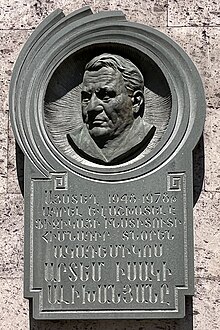Biography
Artem Alikhanian was born in Elizavetpol, Russian Empire, to an Armenian family of a railway engineer and homemaker. They had four children: two sons (the elder, Abram Alikhanov, became a well-known physicist) and two daughters. In 1912 the family moved to Aleksandropol. He worked as a waiter and a newspaper seller. Alikhanian did not attend school regularly; initially he was mostly schooled at home but later he received an external degree from Tiflis school № 100. In 1930, before he graduated from Leningrad State University, he became a staff-member at Leningrad Physico-Technical Institute working together with his elder brother Abram Alikhanov. The work of their group was devoted to the investigation of pair production and of the resultant positron spectrum. For observation of positrons, Alikhanov, his student M. Kozodaev and Alikhanian used an original combination of a magnetic spectrometer and two contiguous Geiger-Müller counters making coincidence counts. This work became a starting point for the application of radio engineering to experimental nuclear physics in the Soviet Union. Before World War II, they carried out fundamental investigations of beta decay, discovered the internal conversion of gamma rays and confirmed experimentally the energy conservation in positron annihilation. In 1934 their research group (B. Dzhelepov, Alikhanov and Alikhanian) was among the pioneers observing the phenomenon of radioactive decay. A method of determining the rest mass of the neutrino, using decay of the nuclei of Be7, was suggested by Alikhanov and Alikhanian in 1938. For their investigations both brothers (without being Communist party members) were awarded the Stalin Prize.
In 1942, they initiated a scientific mission on Mount Aragats in order to search for the third (proton) component of cosmic rays. They found so called narrow showers in cosmic rays and established the first evidence of the existence in cosmic rays of the particles with masses between that of a muon and proton. During the siege of Leningrad Alikhanian and some his colleagues were excused from full-time defense work in order to work on the design of a synchrocyclotron - the accelerator which was eventually constructed in Dubna in 1955. In 1948, A. Alikhanov and A. Alikhanian again were awarded the Stalin Prize for the investigation of cosmic rays. After they founded a cosmic ray station on Aragats at an altitude of 3250 m, the two brothers participated in the foundation of the Armenian Academy of Sciences and established the Yerevan Physics Institute in 1943. A. Alikhanian became its Director for the next 30 years. In 1956, Alikhanian, Alikhanov and Viktor Ambartsumian initiated the creation of the Yerevan Synchrotron with 6 GeV energy of electrons.
In 1965, Harvard University invited Alikhanian to give the Loeb and Lee lectures in Physics. He became the first Loeb professor of Harvard University from Europe. Alikhanian was a Doctor of physical-mathematical sciences, Professor of Yerevan State University, head of the physical laboratory in the Lebedev Institute, founder and scientific supervisor of the Nuclear Physics chair in the Moscow Engineering Physics Institute, founder of the high-altitude Aragats and Nor-Amberd research stations. In recognition of his scientific achievements and contribution he was awarded the "Honored Scientist of Armenian SSR" title in 1967.
For the work on wide-gap track spark chambers in 1970 A.Alikhanian together with the colleagues were awarded the Lenin Prize. Later he initiated work on x-ray transition radiation detectors.
